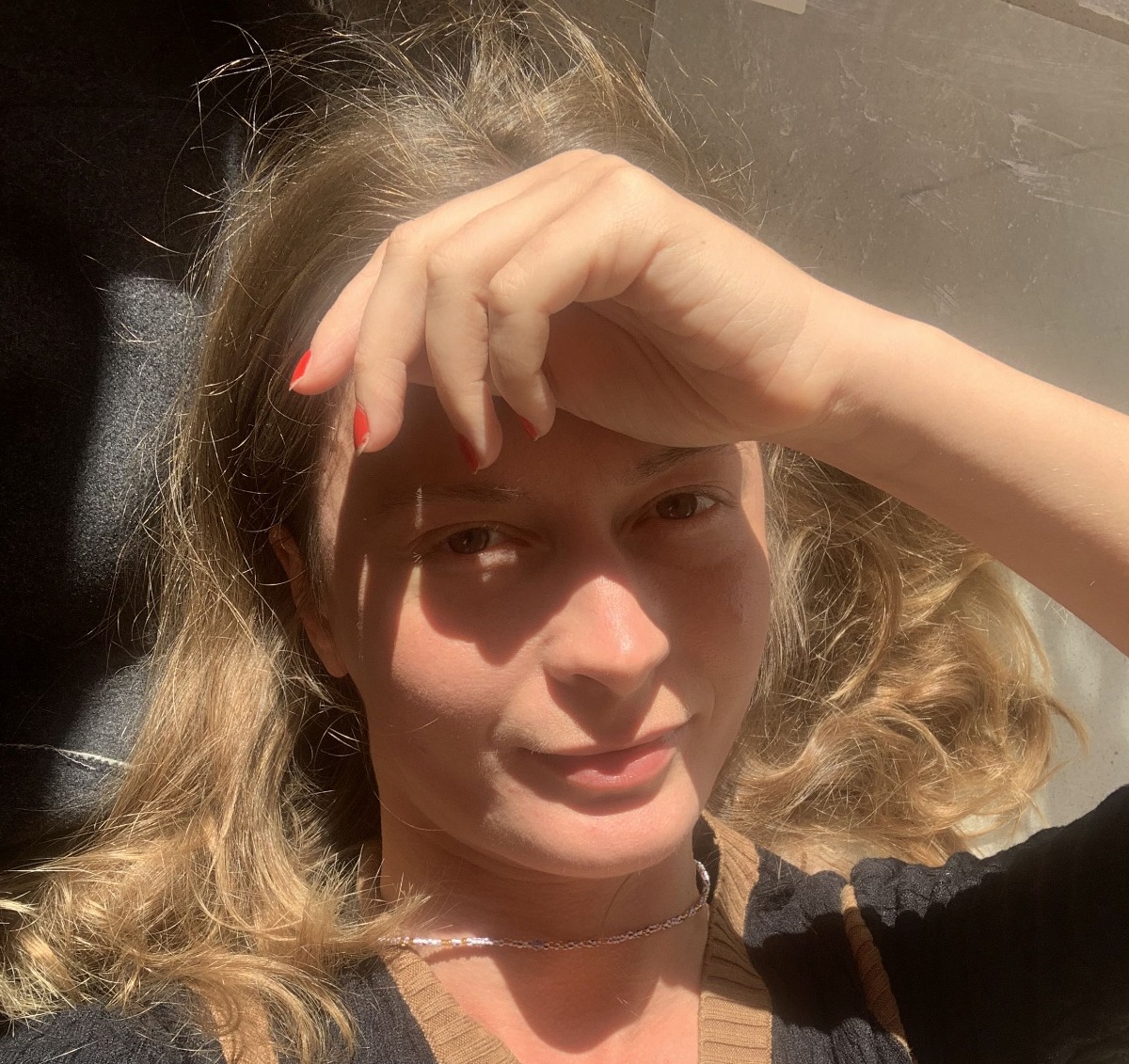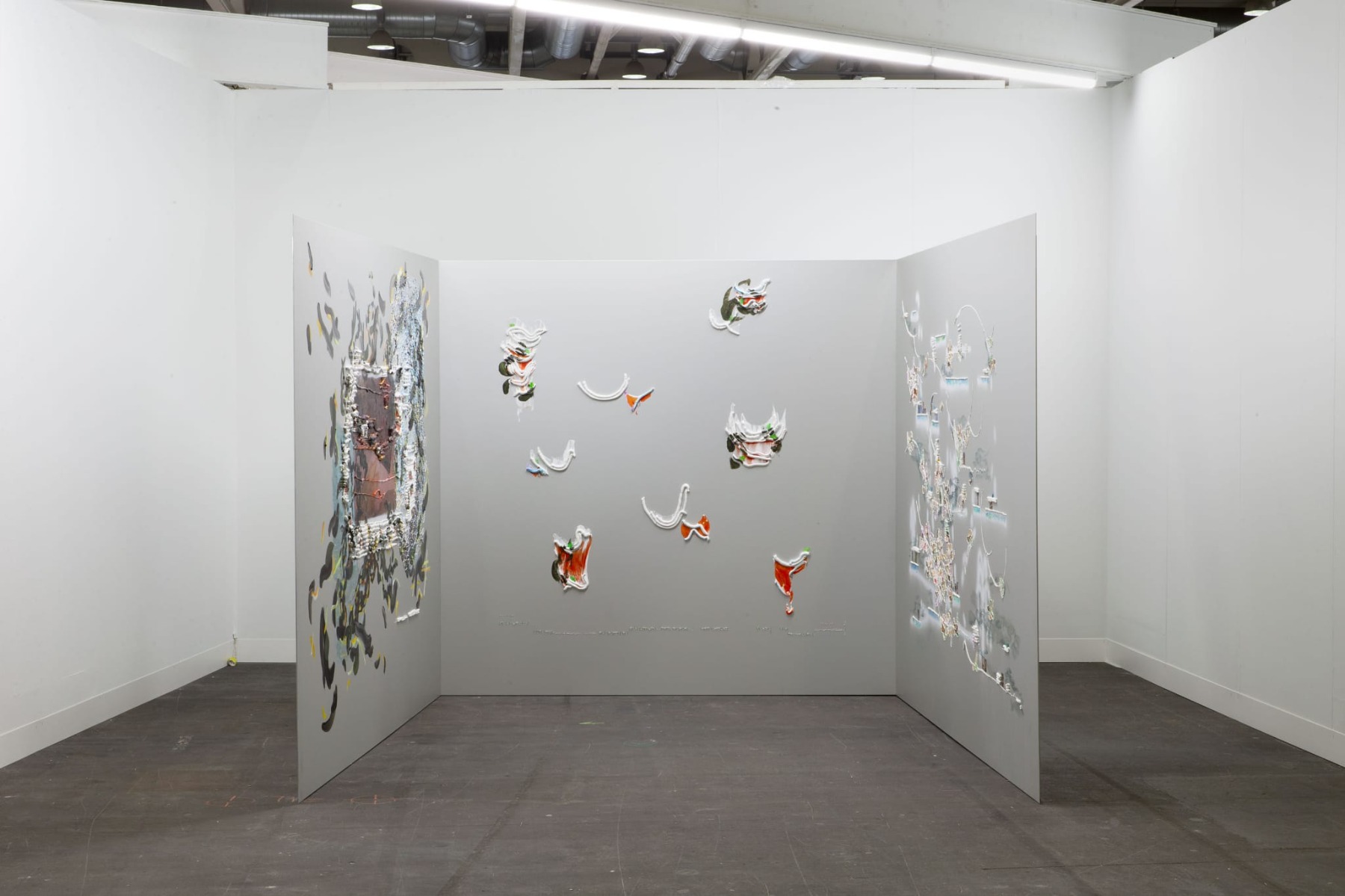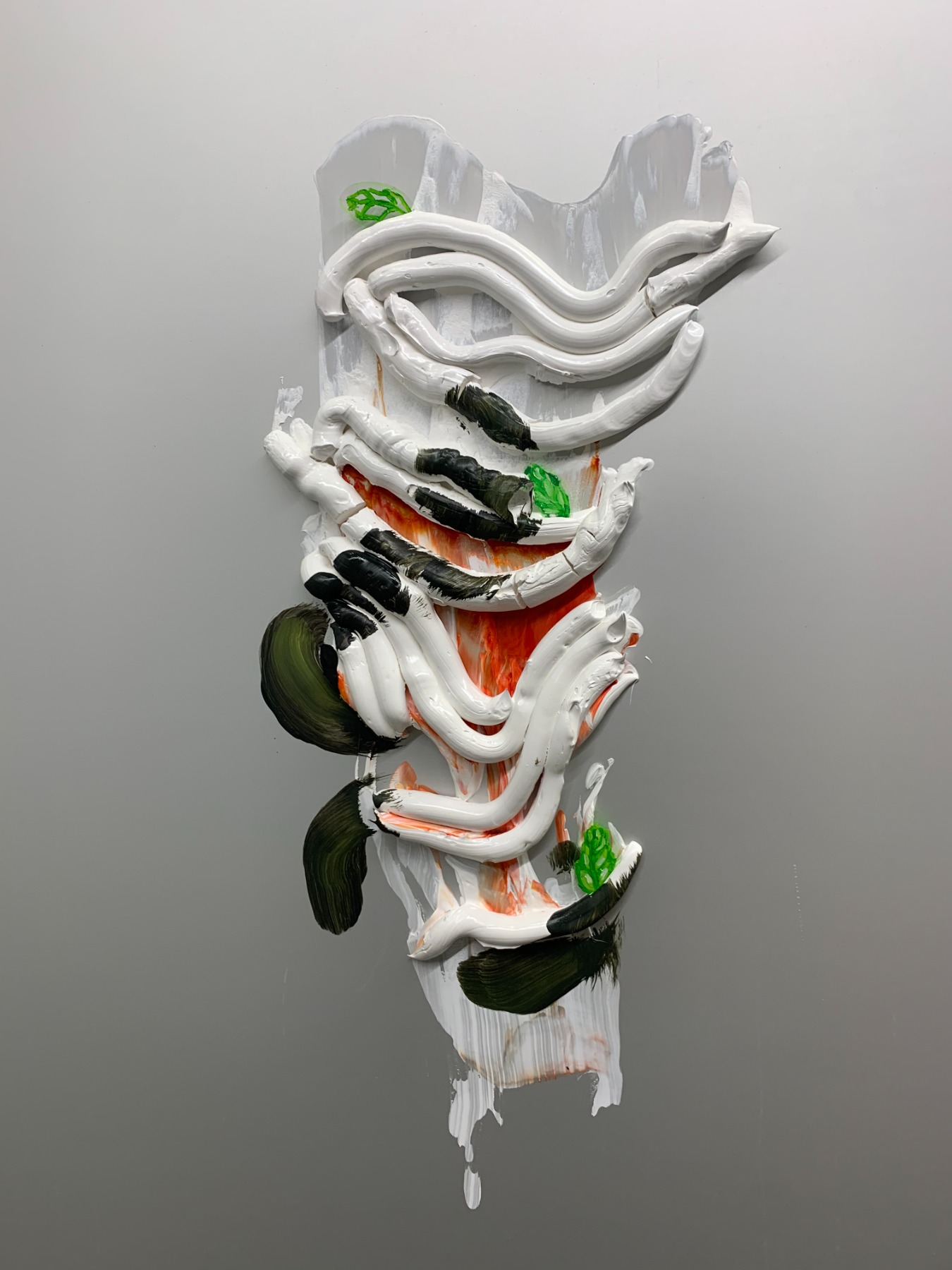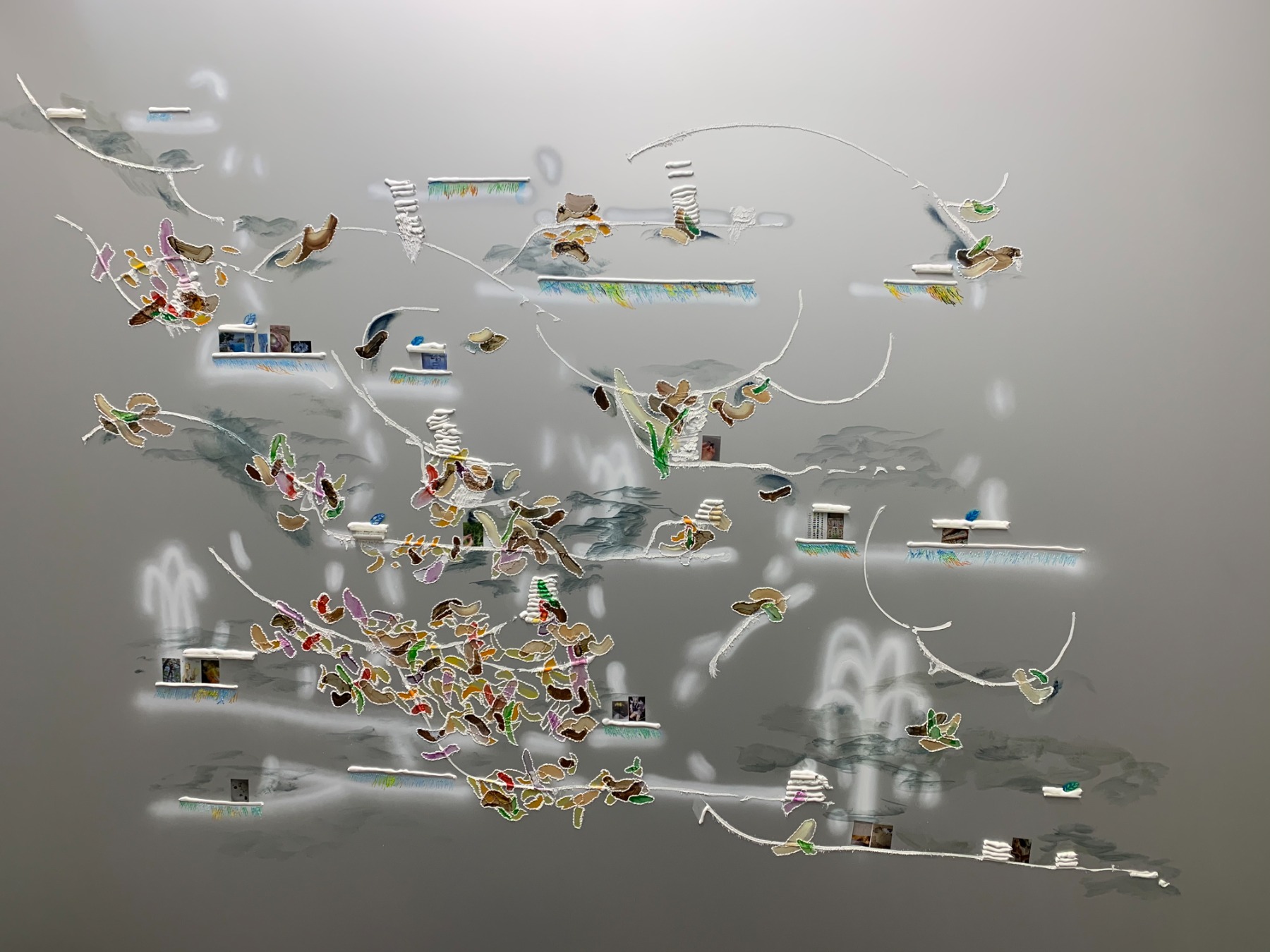
Art is a form of the mind’s reflection on itself and its surroundings
Q&A with Latvian-born, Zurich-based artist Elza Sīle
Latvian-born artist Elza Sīle lives and works in Zurich, Switzerland. In 2019 she graduated from ZHdK Zurich, and in 2021 was already nominated for the Swiss Art Awards and presented a solo booth at Liste Art Fair Basel. She has participated in numerous two-person and group shows. This past winter, the KIM? Contemporary Art Center presented the online exhibition VAGABOND \ A PLACE HARD TO PLACE /, a joint work by the artists Indriķis Ģelzis, Elza Sīle and Joe Namy, co-curators Jo-ey Tang and Zane Onckule, and architect Juris Strangots.
Elza Sīle’s works can also be currently be seen in the exhibition Geometric Opulence at Museum Haus Konstruktiv in Zurich. “My aim was to develop works which would expand the rather weird association that geometric or mathematical procedures in art would look like as a grid or primary figures, which is also a reason why one of the works is called Euclid’s Hut,” says Sīle.
As usual, Sīle prefers to answer any and all questions in writing. Our correspondence began the week before February 24. After that fateful date, most everything had changed; without warning, the question of the role of art during war had now come to the forefront of the artist’s attention.
Elza Sīle's work at the exhibition Geometric Opulence
What is the role of art in a time of war?
Last week was a very difficult one, and to be honest, I was not able to do much secluded interaction with my material; I need a fresh mind and joy for that to happen.
A couple of years ago I started to engage in social media as a very crude form of art practice. While entertaining myself with image-streams, I was thinking of my actions as being similar to those of the Cold War period, when early propaganda videos or photos were fragmented and re-glued into new sequences. It totally surprised me how people still trust a sequence of images even if it is obviously contradictory or fictitious. Running these image sequences is like a form of a training for me, and a question for others – can we notice the priming, the absurd linkages created, and the reflection on the moment when association turns into a memory of a factual event? Namely, issues of manipulative visual rhetoric are crucial in my practice, and I think they are a crucial part of mass education as well. A star that shines bright on a red background and the symmetry of lush laurel leaves is just irresistible glory. I remember the power of imagery and my own fascination with it when I was a child and did not yet have any internal tools of resistance.
Together with the kim? team and curator Zane Onckule, for almost a year we have been planning a solo show on deciphering the thick, dark-green volumes of the LSSR (Latvian Soviet Socialist Republic) Encyclopedia, which, as it turns out, was one of top obscure objects of our early years. For me, the issue of widespread resistance to populist speech and an individual’s critical thinking ability being embedded in various ideological battle fields is more important than the chaotic actions taking place when the cruelty of war is already nearby.
Elza Sīle. Portals at Misako & Rosen, Tokyo. January 16 – February 13, 2022
For this specific moment, well-written art theory directed onto widely misunderstood issues such as the Eastern Block’s “whiteness” and “economic privilege” after the Soviet regime is a necessity. Many artists here in Switzerland are leftists and anti-West oriented, completely ignorant about Eastern Europe’s past, and as a consequence, are rather silent about Russia’s actions or even falling victim to Russia’s propaganda* (www.vice.com/en/article/wxdb5z/redfish-media-russia-propaganda-misinformation). This last week I’ve been writing a lot about politically active artists who freely share and celebrate the symbol of the hammer and sickle while being totally ignorant about the crimes that were committed under this flag and regime in the former Soviet countries. It is important to educate people more.
Katelyn Eichwald, Dominique Knowles, Reina Sugihara, Elza Sīle. Portals at Misako & Rosen, Tokyo. January 16 – February 13, 2022
Could you briefly tell me about your latest projects?
My latest direction is stick/cat-tail paintings, which I developed in my Mom’s basement during the Christmas holidays. It is as if you’re shrinking a usually rectangular painting format into a single dimension – as if the whole painted surface, or skin, is rolled up and crowded onto this skinny trampoline. It is something between a candy called Pocky (a pretzel stick dipped in various sweet coatings with flavors like strawberry or matcha – they’re very popular in Japan) and a very narrow food tray. I would watch my mom or brother cooking and then head to the basement and vaguely imitate their actions while watching YouTube videos of army camouflage techniques and deception strategies in WWII. The result was a weird and slightly dark mixture of algae salad, turning into a blood vessel salad, turning into a military pattern, turning into a laurel leaf decoration crammed next to squeezed oil paint colored like red-white-and-blue Aquafresh toothpaste, next to a miniature painted gelatin army of trench coats or cabbage rolls, next to peppermint ice cream with chocolate chips and a fractal-like gelatin snake skin made from melted bones and integrating text snippets such as “Absolute Intensity” from A. Piatigorsky’s book Philosophy of Politics and “Ghost Army”, which was an impressive fake army created by artists, architects and actors on the Western front during WWII. It was pretty intense and felt extremely risky as I had never even tried this new type of work; most of the techniques I solved during those two weeks were done while knowing that they must work, otherwise I will fail a very nice show at the Tokyo-based gallery Misako & Rosen.
What is your current focus or interest in art? What are you researching and exploring right now? It looks like your paintings are becoming more chock-full, dense and, in a manner, ornamental – perhaps even... oriental?
At the moment I’m taking part in a group show titled Geometric Opulence at Zurich’s Museum Haus Konstruktiv. The museum hosts a huge collection of Swiss and international constructivist art, but it is in active dialogue with the present. The schedule was pretty tight again, and the museum’s director and the curator of this show, Sabine Schaschl, happily permitted me to finish the works on the spot. So I had a really nice private studio as well as access to more information about the direct context of my works to be exhibited. On my right there were two Americans, Peter Halley and Marie Heilmann, and on my left – Swiss pop-artist Sylvie Fleury. During my two weeks there I did some small jokes and commentaries that slightly referred to their works, but mostly my aim was to develop works which would expand the rather weird association that geometric or mathematical procedures in art would look like as a grid or primary figures, which is also a reason why one of the works is called Euclid’s Hut.
Elza Sīle, Haus Konstruktiv group show Geometric Opulence. Photo: Stefan Altenburger
One of my interests is the simultaneous perception of various viewpoints as they slice space and are encompassed in each other, so I would look on over-layering patterns as on a moving topographical map. Also, for a couple of years I entertained myself by going through architectural history or structural possibilities in a very limited and rather oily medium. One day last spring I looked at what my mom was doing with fabrics – sewing and knitting – and thought that it would be interesting to see what it would be like if transferred into oil painting. I was also thinking about the look of fear and desire; about the fact that a partisan war is probably going to be a phenomenon of the past because technology has developed so rapidly; that it is no longer possible to hide; about the state of mind that is common in games and how it echoes in war. I also wanted to achieve a more fluid movement of particles in space, captured at a certain momentum in the surface of the painting. The works I developed for the City of Zurich Stipend and the Swiss Art Awards had some elements from these interests. The Liste Art Fair Basel installation was a huge U-shaped triptych, and the works which I developed in a New York hotel for NADA Miami while traveling were like little food trays containing textual excerpts from hotel descriptions, checks acquired in different parts of the city, and official documents regulating visitors’ entry into the United States.
Elza Sīle. Banana milk ghillie suit, 50x6 cm, acrylic paint and gelatin on plaster coating, 2022. Portals at Misako & Rosen, Tokyo
Elza Sīle. Sicily Dolphin, 50x54cm, acrylic paint and gelatin on plaster coating, 2022. Portals at Misako & Rosen, Tokyo
How important to you is the physical substance of your artworks?
I don’t use contour to delineate recognizable signs or phenomena, but rather imitate its material substance or the feeling it creates; if not that, then the context or configuration resemblance. For example, small brushstrokes that look like grains of rice can be a building block for part of an image if repeated in one way, and soon after become a member of a rice army if arranged into rice troops moving over a previously painted landscape. Or, they can start to fall down from that horizontal illusion because the steep vertical aluminum panel is perceived to be slippery, and when tinted in skin color, they become small subjects crawling and falling over the painting’s surface. Additionally, I also embed commentaries in how substances, tools and techniques are solved and used. Think of it as sinking your consciousness in a pool again and again, welcoming its interaction with the liquid in previously unseen ways. And sometimes it is more like a jacuzzi than a pool – then the complexity of the patterns grows.
Elza Sīle. Stealth coating, 50x5cm, acrylic paint and gelatin on plaster coating, 2022. Portals at Misako & Rosen, Tokyo
Elza Sīle. Strawberry pocky, 50x4cm, acrylic paint and gelatin on plaster coating, 2022. Portals at Misako & Rosen, Tokyo
How has the painting medium changed today compared with the past? Has it even changed? What does painting as a medium mean to you, and why do you prefer it over other tools or techniques? How important for you is it to go beyond the boundaries of conventional painting?
I just enjoy entertaining myself within the two-centimeter thickness of colorful semi-fluid materials and additional structural materials like gelatin or graphite pencil lead. But I could do similar things with readymade installations, or things on the table if there was no paint around. What I like about painting is that its history and connotation field is one of the intellectually broadest ones compared to, let’s say, rubber. Also, I do like works and materials that I cannot immediately recognize or understand. I guess I’m very bored in seeing everyday surfaces; that’s why I invent some for me and others to spend time with.
Elza Sīle's work at the Liste Art Fair Basel solo show with PHILIPPZOLLINGER galerie
You are part of the online project being hosted by the kim? Contemporary Art Center. Considering the bold physicality of your art, how do you feel within the digital world?
Already years ago, together with the architect Juris Strangots, we started building three-dimensional models and situations based on my sketches and explanations and his ability to translate and improve upon them. Units, placements, strange psycho-spatial possibilities. I wanted to do gardens, fountains and mazes, but the computer work is extremely labor intensive – it is faster to paint. Partly, the aluminum surfaces which I sometimes paint on came from the way I treated the rendering space. But in the digital world, it was much easier to see that the scale in my works is really relative and fluctuates from smaller units within another unit within, again, a larger setting, so that the boundaries between the world and the model feel eerie. In the kim? Contemporary Art Center project it was Zane Onckule who had the idea to scale one of my 2m2 folded plate paintings up to a huge spatial installation.
Elza Sīle's work (detail) at the Liste Art Fair Basel solo show with PHILIPPZOLLINGER galerie
Do you think art can serve society and help communities survive difficult times? Can art help us learn and understand ourselves? Can art make life better for humans?
Art is a form of the mind’s reflection on itself and its surroundings. A statement of beliefs, hopes, desires, fears, interesting provocations, a selection of the best jokes, and interaction with others’ ideas. I like and often do put my finger in my nose for no real reason, or stare at women’s asses even if I like men, but I still think it is good to try to imagine better sometimes.
How important to you is the balance between the conceptual background, the narrative of your art, and the formal tools you use? Which of these is most important?
It is a matter of an association network – as I collect mental imagery every day and interact with material daily, small graphite sticks erected in a straight line and then knocked down on a miniature field of disaster might be a very devastating future possibility, or, a commentary on human habits and history. The scale is very small, around one centimeter, so most people would think it’s just some pigeon shit or snot – pretty little things. But sometimes people form a strange intuitive bond to the work and start to see and interpret these little configurations in more expanded narratives. Right now in the Haus Konstruktiv show, most people are curious about my work titled Camouflaged Alley, the one with the little graphite sticks forming long alleys covered with Hooker’s green, narrowly cut gelatin strips. Oftentimes they are attracted to the Japanese seaweed-like, anti-sliding support systems made of flag-colored tubes, which look edible. But then again – this large piece was recently sold to the Department of Justice and Home Affairs of the Canton of Zurich, which is an interesting coincidence.
Elza Sīle's work at the Liste Art Fair Basel solo show with PHILIPPZOLLINGER galerie
You have been away from home for quite a long time – is nomadism good for artists? Does your place of origin determine your art in any way?
This is my sixth year living in Zurich, and before that I lived in Oslo for two years. For me, it is good, yes, as it allows me to focus completely on my work. Memory, reference systems and concerns which I think are important (the necessity to recognize totalitarianism before it closes in) come from experiences and the stories I have been brought up with.
Elza Sīle. Snake's bedroom (detail), Haus Konstruktiv group show Geometric Opulence